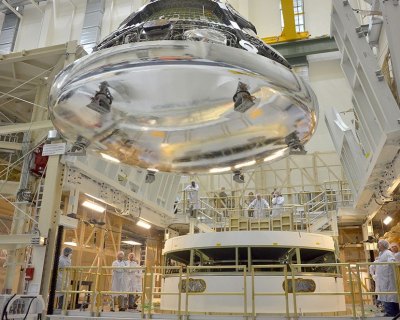NASA's Orion spacecraft takes shape in Florida

For the time being, the new spacecraft is at the Kennedy Space Center in Florida, beginning to look as though ready for flight. Engineers began stacking the crew module on top of the completed service module June 9, the first step in moving the three primary Orion elements –crew module, service module and launch abort system – into configuration for launch, a NASA news release reported.
In Orion's first launch, set for December, an uncrewed flight will go 3,600 miles above Earth in a 4.5 hour test of the systems critical for future human missions to deep space. After two orbits, Orion will re-enter Earth’s atmosphere at almost 20,000 miles per hour before its parachute system deploys to slow the spacecraft for a splashdown in the Pacific Ocean.
Orion's flight test also will provide important data for NASA's Space Launch System (SLS) rocket. In the future, Orion will launch on the SLS. More powerful than any other rocket, SLS will be capable of sending humans to deep space destinations such as an asteroid and eventually Mars. Exploration Mission-1, scheduled for 2017, will be the first mission to integrate Orion and the Space Launch System.
Orion was built as the exploration vehicle that will carry crew to space, provide emergency abort capability, sustain the crew during space travel and provide safe re-entry from deep space, according to NASA's website.
Related:
NASA In Brief --Students to compete in rocket challenge; launch manufacturer chosen

